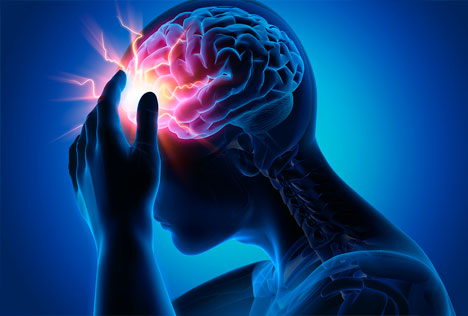Botox for Migraines
 Botox is a safe product that’s been used to treat cosmetic facial wrinkles since 2002. It works by interfering with muscle nerves, so they don’t respond to commands to move. As a result, the muscles freeze into place, eliminating crow’s feet, glabellar lines, and forehead furrows. As a cosmetic product, Botox has been extremely popular.
Botox is a safe product that’s been used to treat cosmetic facial wrinkles since 2002. It works by interfering with muscle nerves, so they don’t respond to commands to move. As a result, the muscles freeze into place, eliminating crow’s feet, glabellar lines, and forehead furrows. As a cosmetic product, Botox has been extremely popular.
Composed of a derivative of the botulinum toxin, Botox is administered through injections into the muscles just beneath the skin. A professionally trained dermatologist should do these injections since you can suffer side effects of Botox is delivered improperly. Make sure your doctor or Dr. Bard on Upper East Side or Midtown Dermatology has experience and training using Botox.
A Non-Toxic Toxin
While Botox comes from the same toxin that can cause botulism, there is absolutely no danger of catching this disease from Botox injections. First of all, the dosage is so low that there has never been a case of botulism from Botox injections. Second, the compound is injected into a muscle, not ingested with bad food through your stomach.
The toxin is just strong enough to temporarily disable the movement of very specific muscles. It works by blocking the nerve function in the muscles it’s injected into. When fighting wrinkles, Botox essentially freezes facial muscles, so the wrinkles you normally see when you smile disappear because the muscles aren’t contracting.
Fighting Migraines
From 2002 to 2012, Botox was used solely for cosmetic dermatology. In 2012, the U.S. Food and Drug Administration (FDA) approved Botox for another use: preventing and treating the chronic pain of migraine headaches. While it might not seem like an obvious application, it has obvious benefits, and it works.
While scientists and researchers don’t know exactly how Botox relieves the pain of chronic migraine headaches, some have theorized that since it blocks nerves from sending signals to the brain, Botox also blocks pain messages from reaching your brain. The toxin definitely relaxes the muscles it affects, so you won’t feel any tenderness.
Who Benefits from Botox for Migraines
 Botox can be prescribed for adults who suffer from chronic migraine headaches. Chronic migraine sufferers are defined as people who:
Botox can be prescribed for adults who suffer from chronic migraine headaches. Chronic migraine sufferers are defined as people who:
- Are at least 18 years old
- Suffer the debilitating effects of migraine headaches
- Have been fighting migraines off and on for the past four months
- Have experienced migraines for at least 15 days a month
- Feel the migraine pain for four or more hours each time
If you fall into this category and are otherwise healthy, talk to your NYC dermatologist about getting a Botox treatment to help relieve the pain and suffering you’ve felt from migraine headaches. Botox has provided measurable relief for many people throughout the New York City area. However, do not seek Botox for migraines if:
- You’re allergic to the ingredients of the formula
- You have a skin issue such as an infection or disease at any of the injection points
- You already have problems that match the Botox side effects (see below)
- You suffer from a bleeding condition
- You’ve had recent surgery
Botox as a Medical Drug
Like many secondary or supplemental uses for a prescribed drug, Botox for migraines came about by accident. No one went looking for a way to use Botox to fight headaches. After the initial reports, thorough testing proved the efficacy of the technique, which led to the FDA approving it. Given the minimal side effects and proven results, you should feel safe undergoing this treatment.
To kill the pain that comes from migraine headaches using Botox, your Manhattan dermatologist gives you a series of injections into your face and neck. The Botox formula for medical use is different than the Botox used for cosmetic reasons. Make sure your doctor uses the correct formula and the correct dilution.
Normally, you receive between 100 and 200 units of Botox, and the average is about 150 units. That’s one to two bottles. For comparison, an average person uses about 50 units to clear up facial wrinkles. So you need more medication to get the best results for your headaches.
The Botox Injections
When you visit a specially trained dermatologist in NYC for Botox injections to curb the pain of migraine headaches, you’re made comfortable while your doctor prepares the medicine. You don’t need any topical anesthetic because the needle used is tiny, so pain during the procedure is minimal. Most people say the injections feel like a pinprick.
The whole procedure takes just 15 minutes in your dermatologist’s office. You receive a total of 31 injections into key muscles all around your head. Your doctor focuses on seven areas:
- Left forehead
- Right forehead
- Above your left ear
- Above your right ear
- Behind your left ear
- Behind your right ear
- At the base of your skull in the back of your head
Recovery, Results, and Follow-up
Your safety and comfort are of paramount concern during a Botox treatment for migraines. Once the injections are complete, you should feel no different and can return to normal activity immediately as long as you avoid strenuous activity for a couple of days. You must avoid rubbing the injection spots, however, since that’s how most side effects occur.
After your first treatment, you may not notice any change in your migraine pain until after two to three weeks. After that, you should notice a dramatic decrease in the number and intensity of your migraine headaches. You have to repeat this procedure every 12 weeks for best results and to maintain your new pain-free life.
Side Effects of Botox for Migraines
Side effects from a Botox treatment have been reported in only about two percent of all patients, so the risks are small. Common side effects from this procedure include:
- Mild injection site pain
- Headache pain
- A drooping eyelid
- Loss of movement in some facial muscles
- Mild muscle soreness, stiffness, weakness, or spasms
- Flu-like symptoms
- Blood pressure increase
All these side effects are temporary and abate on their own. However, in very rare cases, you can experience more serious side effects. If you have any of the following symptoms after your Botox treatment, contact your doctor right away:
- Trouble breathing
- Trouble swallowing
- Slurred speech
- Weakness throughout your body
- Double or blurry vision
- Bladder control issues
Beat Your Migraine
Contact a specially trained NYC dermatologists to schedule an initial appointment for an evaluation. Remember that Botox treatments may take a couple of weeks to work. Since this use of Botox is medically approved, your insurance company covers the procedure, but you can check before your appointment.
Important Reminder: This information is only intended to provide guidance, not definitive medical advice. Please consult dermatologist NYC about your specific condition. Only a trained, experienced board certified dermatology doctor or pediatric dermatologist could determine an accurate diagnosis and proper treatment.
Locations: Manhattan Dermatology (Upper East Side) 983 Park Ave, Ste 1D1, NY 10028(212) 427-8750 Manhattan Dermatology (Midtown) 56 W 45th St, Ste 819, NY 10036
(212) 889-2402 Manhattan Dermatology (Union Square) 55 W 17th St, Ste 103, NY 10011
(212) 378-9984

